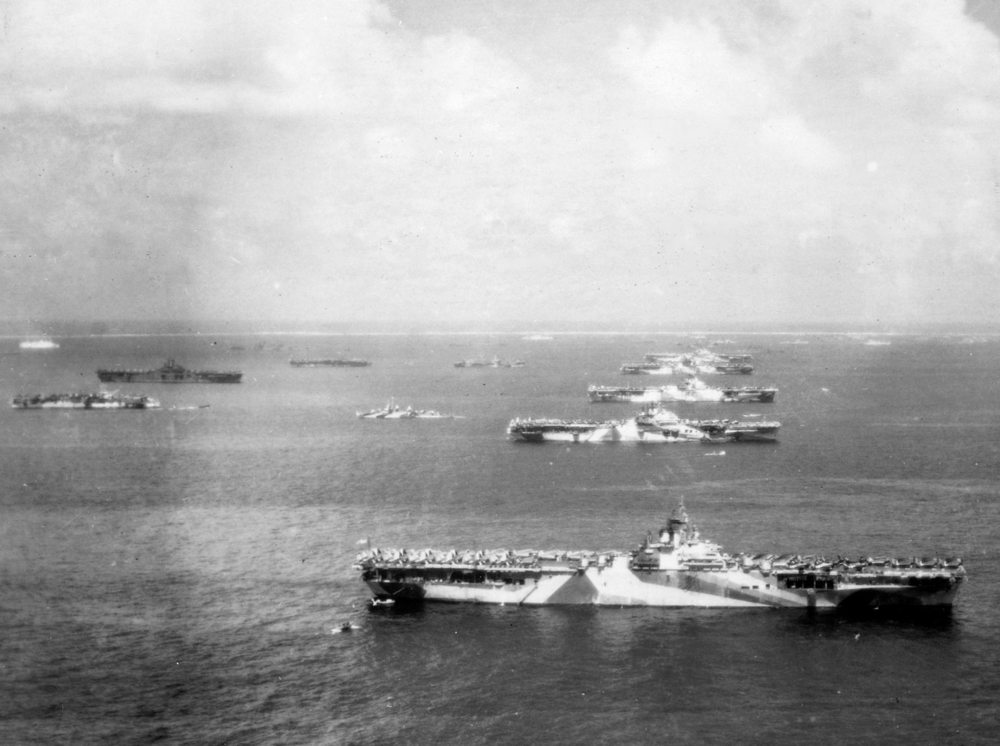Contrary to common belief, the dropping of the atomic bombs on Hiroshima and Nagasaki didn’t make the invasion of Japan unnecessary. In fact, the invasion of Japan began on 1 July 1945 when Task Force 38 left its anchorage in the Philippines to begin Phase One of Operation Olympic, the invasion of the southernmost of the Home Islands, Kyushu. The amphibious landings on Kyushu were set for November 1945 and Kyushu would then be used as a base of operations for Operation Coronet, the invasion of Honshu and the capture of Tokyo set for the spring of 1946. By this point in the war, the US Navy’s Fast Carrier Task Forces had eclipsed the Imperial Japanese Navy’s Kido Butai (Mobile Strike Force) of the first half of the Pacific War as the most powerful naval strike unit of the war. Phase One of Operation Olympic was for the powerful Task Force 38 to conduct raids on the Japanese Home Islands in preparation for the November landings.
Commanding TF38 would be Admiral William “Bull” Halsey and Vice Admiral John S. McCain. TF38 was made up of Task Groups, each group centered around 5-6 aircraft carriers supported by 2-3 battleships, cruisers and 2-3 destroyer squadrons. Halsey flew his flag aboard the battleship USS Missouri while McCain had his flag on the newest Essex-class fleet carrier, the USS Shangri-La. (the prior link will take you to a detailed order of battle for TF38). In concert with the US Army Air Forces’ B-29 Superfortress offensive, TF38’s aircraft would be hitting pinpoint targets that the B-29s were unsuited to go after- airfields, harbors and dockyards, coastal shipping and transportation chokepoints.
Once within striking range of the Home Islands on 10 July, the sailors and airmen of the TF38 awaited the kamikaze onslaught and expected fierce air resistance over the target areas. To their surprise, they literally had air superiority over even Tokyo with little effort. The Japanese were expecting the landings in October and saw no use in fighting the growing number of American aircraft attacking the Home Islands, instead they chose to stockpile and husband their airpower for use to defend against the expected landings. The aviators of TF38 turned their attention to coastal targets around Kyushu, but the pickings were slim. With intelligence reports indicating a far better target would be the coal industry on the northern Home Island of Hokkaido, TF38 moved north to disrupt Japanese industry by going after its power source. The factories on Honshu, the main island, got over 80% of their coal from Hokkaido in the north. Disrupting the rail lines on Hokkaido would further hamper the transport of coal from the mines southward. On 14 July alone 850 sorties were carried out against various targets in Hokkaido from airfields, rail lines and harbors. Many of the harbors were crowded with merchant ships who were trying to avoid the minefields that had been sown by the B-29 Superfortresses.
It was during the strikes on Hokkaido that the Navy discovered the Achilles heel of the Japanese industry. As there were no bridges or tunnels linking Hokkaido to Honshu at the time, they relied on train ferries to move coal cars from the port of Hakodate on Hokkaido across the Tsuguru Strait to the port of Aomori on Honshu. In the 1920s as Japan’s industrialization increased, four 3,400 ton ferries were built that could carry 25 rail cars across the Tsuguru Strait. Larger ferries were built in the late 1920s that could carry up to 43 rail cars. A dozen of these ships were the only way to move coal from the mines in Hokkaido to the factories in Honshu. Eight of the ferries were sunk by TF38’s aviators and an eighth was forced aground. The air wing of the USS Essex alone accounted for four of the precious train ferries. Coal shipments were quickly moved by the Japanese to smaller coastal merchantmen, but they were inadequate for the task and they were just as much targets for the prowling aircraft of TF38 as the train ferries. The effect was dramatic- in just two days, the amount of coal available to factories on Honshu dropped by a staggering 80%.
The contribution by targeting the train ferries presented the Navy’s brass with a dilemma. For most of the Pacific War and the years prior carrier aviation strategy centered around attacking and sinking the enemy fleet at sea, but the carrier strikes against the coal industry of Hokkaido showed that hitting unglamorous targets like train ferries contributed for more to the war effort. This would have a great influence on one of the task group commanders of TF38, Rear Admiral Arthur Radford. In the postwar period, Radford served as the Vice Chief of Naval Operations, Commander of the Pacific Fleet and Chairman of the Joint Chiefs of Staff. In those various capacities he consistently pushed for a strong naval aviation arm.
Source: Whirlwind: The Air War Against Japan 1942-1945 by Barrett Tillman. Simon & Schuster, 2010, pp 199-202. Photos: US Navy

